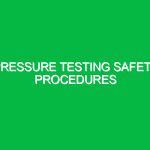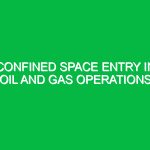Introduction
Pipeline integrity and inspection practices are critical components in the Health, Safety, and Environment (HSE) domain. These practices ensure that pipelines, which transport liquids and gases, operate safely and efficiently. Maintaining pipeline integrity is essential for preventing leaks and failures that can lead to environmental damage, health risks, and significant financial losses. The relevance of these practices extends beyond regulatory compliance; they safeguard human life and protect natural resources. This article offers a detailed overview of pipeline integrity and inspection practices, outlining associated risks, safety precautions, best practices, and regulatory standards.
Understanding Pipeline Integrity
Pipeline integrity refers to the condition of a pipeline and its ability to perform its intended function without failure. It encompasses the physical state of the pipeline, the materials used, and the environmental factors affecting its operation. Maintaining pipeline integrity involves regular inspections, maintenance, and monitoring to detect any signs of deterioration or damage. Effective pipeline integrity management helps prevent leaks, reduces the risk of accidents, and ensures compliance with legal and regulatory requirements.
Potential Hazards and Risks
While pipelines are crucial for the transport of essential resources, they also pose various risks. Understanding these hazards is vital for developing effective inspection practices.
1. Corrosion
Corrosion is one of the leading causes of pipeline failure. It occurs due to chemical reactions between the pipeline material and its environment, leading to material degradation. Factors such as moisture, temperature variations, and soil composition can accelerate corrosion. Regular monitoring and maintenance are necessary to identify and mitigate corrosion risks.
2. Mechanical Damage
Mechanical damage can arise from external impacts, such as construction activities or natural events like landslides. These incidents can compromise the structural integrity of pipelines. Implementing protective measures and conducting thorough inspections are essential to prevent mechanical damage.
3. Third-Party Interference
Pipelines are often buried underground, making them susceptible to interference from third parties. This includes construction activities, agriculture, or unauthorized excavation. Increased awareness and communication with local communities can help mitigate this risk.
4. Environmental Factors
Environmental factors such as temperature fluctuations, seismic activity, and flooding can impact pipeline integrity. These factors can lead to stress on pipeline materials, resulting in cracks or ruptures. Regular risk assessments and environmental monitoring are crucial for addressing these challenges.
5. Operational Failures
Operational errors, such as overpressure or improper handling of materials, can lead to pipeline failures. Comprehensive training and adherence to operational protocols can help minimize these risks.
Safety Precautions and Best Practices
Implementing effective safety precautions and best practices is essential for maintaining pipeline integrity and ensuring safe operations.
1. Regular Inspections
Conducting regular inspections is a fundamental practice in pipeline integrity management. Inspections should include visual assessments, non-destructive testing, and monitoring for leaks. Using advanced technologies such as drones or robotic systems can enhance the efficiency of inspections.
2. Integrity Management Programs
Establishing a robust integrity management program is crucial. This program should include risk assessment, data analysis, and a proactive approach to maintenance. Regular reviews and updates to the program can help adapt to changing conditions.
3. Training and Awareness
Providing training for employees and stakeholders is vital for promoting safety awareness. Training should cover the importance of pipeline integrity, potential hazards, and emergency response protocols. Engaging with local communities can also foster understanding and cooperation.
4. Use of Technology
Leveraging technology can significantly enhance pipeline inspection practices. Implementing smart sensors, remote monitoring systems, and data analytics can provide real-time insights into pipeline conditions. These tools enable timely interventions and improved decision-making.
5. Emergency Response Planning
Developing a comprehensive emergency response plan is essential for addressing potential incidents. This plan should outline procedures for leak detection, containment, and communication with relevant authorities. Regular drills and assessments can ensure preparedness.
Regulations and Standards
Adhering to regulations and standards is paramount in pipeline integrity and inspection practices. Various organizations provide guidelines to ensure safety and compliance.
1. American Petroleum Institute (API) Standards
The API sets industry standards for pipeline integrity management. These standards cover design, construction, operation, and maintenance of pipelines. Companies must comply with these standards to ensure safe operations.
2. Department of Transportation (DOT) Regulations
In the United States, the DOT regulates pipeline safety through the Pipeline and Hazardous Materials Safety Administration (PHMSA). These regulations establish requirements for pipeline integrity management, inspections, and reporting.
3. International Organization for Standardization (ISO) Standards
ISO standards, such as ISO 55001 for asset management, provide frameworks for managing pipeline integrity effectively. Compliance with ISO standards can enhance operational efficiency and safety.
Conclusion
Pipeline integrity and inspection practices play a crucial role in the Health, Safety, and Environment domain. By understanding the potential hazards and risks associated with pipelines, organizations can implement effective safety precautions and best practices. Adhering to regulations and standards enhances operational safety and protects natural resources. Through regular inspections, robust integrity management programs, and the use of advanced technology, companies can ensure the safe transport of essential resources while minimizing risks to human health and the environment. Prioritizing pipeline integrity is not just a regulatory requirement; it is a commitment to safety, sustainability, and responsible resource management.


